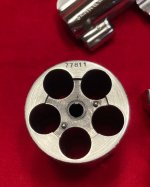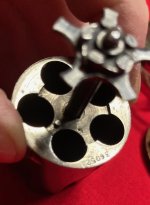I have a few Chiefs Special and Terrier examples living in the stable. I have a recent addition, a nickel plated baby Chiefs Special. I was bragging it up a bit to a fellow collector, mentor, and well known authority on these little things, and explaining where the "N's" are. I didn't see one on the cylinder under the ejector star, but my mentor said 'check again'. I did, and there it was. I looked right through it on first inspection, but perhaps had a reason or two to do so. My eyes aren't the greatest these days, and there is a dimple that was applied over top of part of the N.
This prompted me to look at a few other Chiefs and Terriers to see if the dimple is always there. Perhaps half of mine have a dimple that is obvious. So this prompts the question "What is the dimple for?" Do your revolvers have a dimple? And, of course, what purpose does it serve.
I will offer a guess on purpose.... Is it to test heat treating/metal hardness? (I offer up that guess as I have seen some USGI weapons sporting a similar dimple and my understanding is that it was a test for hardness.)
I will attach a few pictures, and I welcome your thoughts related to what and why they are!
(All three examples are nickel. Is there a correlation there, or is it coincidence?)
And notice that two out of three touch the "N".
Here's one on a Terrier, likely dated around 1953, at about 10:00 under the star.


And another Terrier at about 12:00


and a Chiefs Special at about 5:00


This prompted me to look at a few other Chiefs and Terriers to see if the dimple is always there. Perhaps half of mine have a dimple that is obvious. So this prompts the question "What is the dimple for?" Do your revolvers have a dimple? And, of course, what purpose does it serve.
I will offer a guess on purpose.... Is it to test heat treating/metal hardness? (I offer up that guess as I have seen some USGI weapons sporting a similar dimple and my understanding is that it was a test for hardness.)
I will attach a few pictures, and I welcome your thoughts related to what and why they are!
(All three examples are nickel. Is there a correlation there, or is it coincidence?)
And notice that two out of three touch the "N".
Here's one on a Terrier, likely dated around 1953, at about 10:00 under the star.

And another Terrier at about 12:00

and a Chiefs Special at about 5:00

Last edited:

